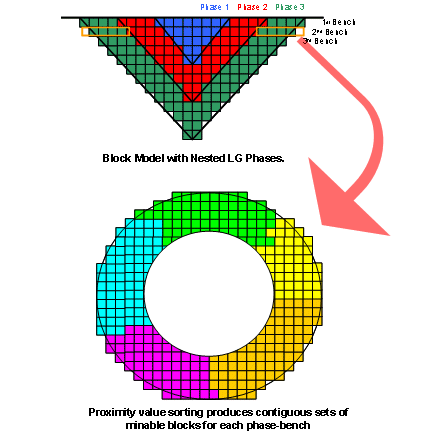What is the Optimal Extraction Sequence?
Calculation of the ultimate pit gives rise to 'phases'. Each phase can be thought of as consisting of horizontally “sliced” benches where each bench is made up of layers of blocks in the geological block model. An Optimal Extraction Sequence of the model blocks which represents the highest possible NPV is determined by considering each phase in turn and then within each phase considering each bench (a “phase-bench”) in turn from the shallowest to the deepest. This is based on the reality that in an open pit mine extraction has to proceed generally from the surface down!
To determine the block sequence within a phase-bench the blocks in the bench are sorted in order of value from the highest to the lowest - once again seeking to maximize the NPV by selecting the highest value first. However, the value that is used in this sorting process to determine a block’s relative position in the extraction sequence in the phase-bench is not simply the intrinsic block value as calculated in the economic model. Using this approach would be simplistic and lead to extraction sequences that, while not random, might be neither practical nor desirable from the mining point of view.
Therefore blocks are assigned a more sophisticated value for sorting known as their “proximity value” and it is this value that is used for determining a block’s position in the extraction sequence. In brief for each phase-bench the block with the highest intrinsic value is first selected for consideration. The remaining blocks are then sorted according to a metric that is a combination of each block’s intrinsic value and its proximity to the current block. This metric value is referred to as a proximity value. As each block is assigned a position in the sequence it becomes the current block for consideration.
To represent this concept graphically:

Using this proximity value to determine when a block is extracted can change the order of extraction considerably. A block of relatively low intrinsic value may be pushed up the extraction sequence order because it is physically closer to blocks with a higher intrinsic value. This is intuitively what mine production personnel do when extracting ore while still adhering to the overall strategic plan. One of the consequences of this mathematical approach is that it tends to create large groups of contiguous blocks for extraction which in turn leads to practical and efficient mining.
Your product's understanding of these practical mining factors (while always honouring pit wall slope constraints) creates an extraction sequence which is more realistic than the simple sorting of the blocks into a sequence based on the calculated or intrinsic block value.
This process is repeated for each bench in each phase until the ultimate pit is exhausted. The extraction sequence that is created using this method is called the Optimal Extraction Sequence (OES) as it provides the highest practical possible NPV for the ultimate pit.
Your product actually generates two optimal extraction sequences, one being a refined version of the other. This initial OES does not take practical engineering implications into account and therefore represents the extraction sequence that is optimal only without the real-world influences of pit operation considerations.
For this reason, this initial sequence is often referred to as the Ultimate Pit OES. Later in the scheduling process, a sequence will be generated that takes the practical implications of generating pushbacks into account, and this is referred to as the Pushback OES.
Other modules within Studio NPVS also generate optimal extraction sequences, such as Mine Flow Optimizer (MFO).
Related topics and activities

